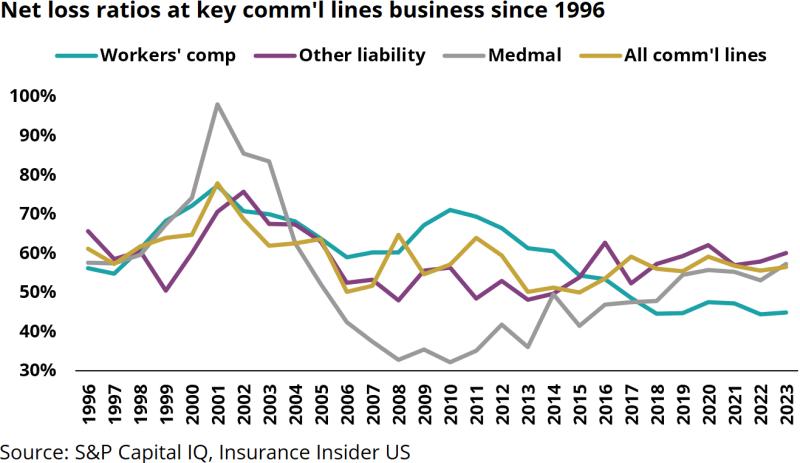
The 78th annual Workers’ Compensation Institute Conference brought together 5,000 industry professionals in Orlando last week, and these were the top-of-mind issues and themes facing the sector for the rest of 2024 and into 2025.
1. First responders' presumption claims legislation has evolved into increasingly active litigation, as mental injury claims rise and discrepancies in state laws are contested.
Presumptive claims for first responders related to PTSD, heart disease and cancer in fire service have become one of the most difficult and contentious areas of law for adjusters and risk managers handling public sector entities, one panel discussed.
Mark Walls, VP for communications & strategic analysis at Safety National, moderated a conversation with panelists Marguerite Jonak, esq., Greg McKenna, national practice leader at Gallagher Bassett and Florida-based attorney Geoff Bichler.
With each state individually addressing the specific problems related to this population of public servants, there is a lack of uniformity in approach to these claims, and a great deal of uncertainty about coverage, in line with Insurance Insider US's reports.
Additionally, because many presumptive laws are relatively new, there is not a body of case law defining the parameters of coverage or interpreting ambiguities in the law.
As a result, presumptive claims are often contentious and technical denials are often asserted without regard for the secondary costs associated with them, according to panelists.
In the audience, a Florida representative shared the plight facing her community, which has suffered the loss of 19 firefighters and police officers to suicide so far this year.
Florida's legislative process, influenced by the Pulse shooting in 2016, led to a bipartisan bill for PTSD benefits. However, many claims are still being denied due to ambiguous statutes.
Panelists and attendees stressed the need for discrete, bipartisan and community-supported legislation that addresses the specific problems of these claims with balanced costs.
Determining these costs remains difficult however, due to incomplete data and the lack of self-insurance data, panelists said.
The conversation offered some hope highlighting the successes of San Diego's approach, where presumption laws have expanded to include heart, cancer and other conditions for various first responders and healthcare workers.
These presumptions are likely to continue to expand, as more arguments are being made to include other worker types such as corrections officers and forest park rangers.
Walls raised the issue of creating distinctions between public and private sectors and the potential impact on the broader workforce, solidifying the staying power of this issue and future implications for all work comp insurers.

2. 'Are injuries worsening?' – data suggests yes.
Workplace injury trends have fluctuated over the last decade. Injury claims ticked up slightly in 2022 compared to 2020 but were still lower than pre-pandemic 2019.
Lower injury rates have provided minimal relief to overall claims costs as medical inflation has risen over 3% in the first seven months of this year alone, paired with a nearly 4% increase in disability costs.
Industry participants highlighted other major factors at play, analyzing unemployment rates and the impacts of an aging workforce.
The unemployment rate – around 4% – is affecting injury rates, panelists said, especially among lower-tenured employees as studies show a higher frequency of injuries among younger and older workers.
Studies from WCRI and Travelers suggest that higher unemployment rates may lead to more or fewer injuries, as employees adopt one of two mindsets: while some employees are filing more to keep their jobs, others are filing less to keep their jobs.
Age group demographics seem to be the biggest factor at play, with injuries heavily concentrated among younger workers aged 22 and under and older workers aged 55-64.
Travelers reported that tenured employees of less than one-year now account for 35% of workplace injuries, while WCRI found that those aged 25 and under reported more frequent injuries than those 55 and older.
From 1996, studies show the percentage of workers aged 55-64 will have doubled and workers 65 and older tripled by 2026.
The costs of workers' compensation claims increase with age as injuries become more likely and more severe. Older workers are also slower to return to work after an injury, further worsening claim costs, duration of treatment and treatment outcomes.
3. Workplace violence is a leading cause of fatal occupational injuries.
A 2024 survey from Trailant identified workplace violence as now the third-leading cause of fatal occupational injuries in the US.
Each year sees two million victims of workplace violence in the US, with 20,000 experiencing physical trauma. These incidents pose an annual cost to employers of $121bn according to the DOJ.
Panelists from Marsh – William Liebler, Dennis Tierney and Renata Elias – discussed the risks and consequences of workplace violence and how the issue relates to workers' compensation mental claims.
The discussion highlighted the importance of identifying warning signs, implementing preventive measures and understanding the legal and financial implications of workplace violence incidents.
In California this topic is timely, as Senate Bill 553 took effect on July 1, requiring most employers to implement basic protections to safeguard employees at work.
The bill requires employers to implement a comprehensive workplace violence prevention plan, create and maintain a violent incident log, develop and carry out employee training and establish a record-keeping program.
